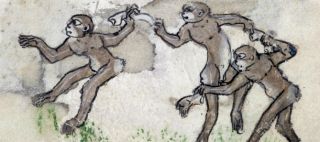Binaural Beats
Why Humans Can, But Apes and Monkeys Can’t Sync to the Beat
Without it no music: Rhythmic entrainment seems a crucial skill.
Posted January 19, 2014

Despite their genetic proximity, human and non-human primates differ in their capacity for ‘beat induction’, which is the ability to perceive a regular pulse in music or auditory stimuli and accordingly align motor skills by way of foot-tapping or dancing. Also referred to as ‘rhythmic entrainment’, this ability is specific to humans and certain bird species, but is surprisingly enough not obvious in non-human primates. These are the findings of researchers from the University of Amsterdam and the National Autonomous University of Mexico (UNAM), whose new hypothesis, the ‘gradual audiomotor evolution hypothesis’, was recently published in the scientific journal Frontiers in Neuroscience.
The gradual audiomotor evolution hypothesis accommodates the fact that non-human primates’ (i.e., macaques) performance is comparable to humans in single interval tasks such as interval reproduction, categorisation and interception, but show differences in multiple interval tasks such as rhythmic entrainment, synchronisation and continuation. The hypothesis is also in line with the observation that macaques can apparently synchronise in the visual domain, but show less sensitivity in the auditory domain. Finally, while macaques are sensitive to interval-based timing and rhythmic grouping, the absence of strong coupling between the auditory and motor system of non-human primates might explain why macaques cannot rhythmically entrain in the way humans do.
The gradual audiomotor evolution hypothesis is an alternative to the well-known ‘vocal learning hypothesis’, which suggests that only species who can mimic sounds share the ability for beat induction. Because recent empirical findings have challenged this hypothesis, an alternative was needed.
Merchant, H. & H. Honing (2014). Are non-human primates capable of rhythmic entrainment? Evidence for the gradual audiomotor evolution hypothesis. Frontiers in Neuroscience, 7, 274. doi 10.3389/fnins.2013.00274


